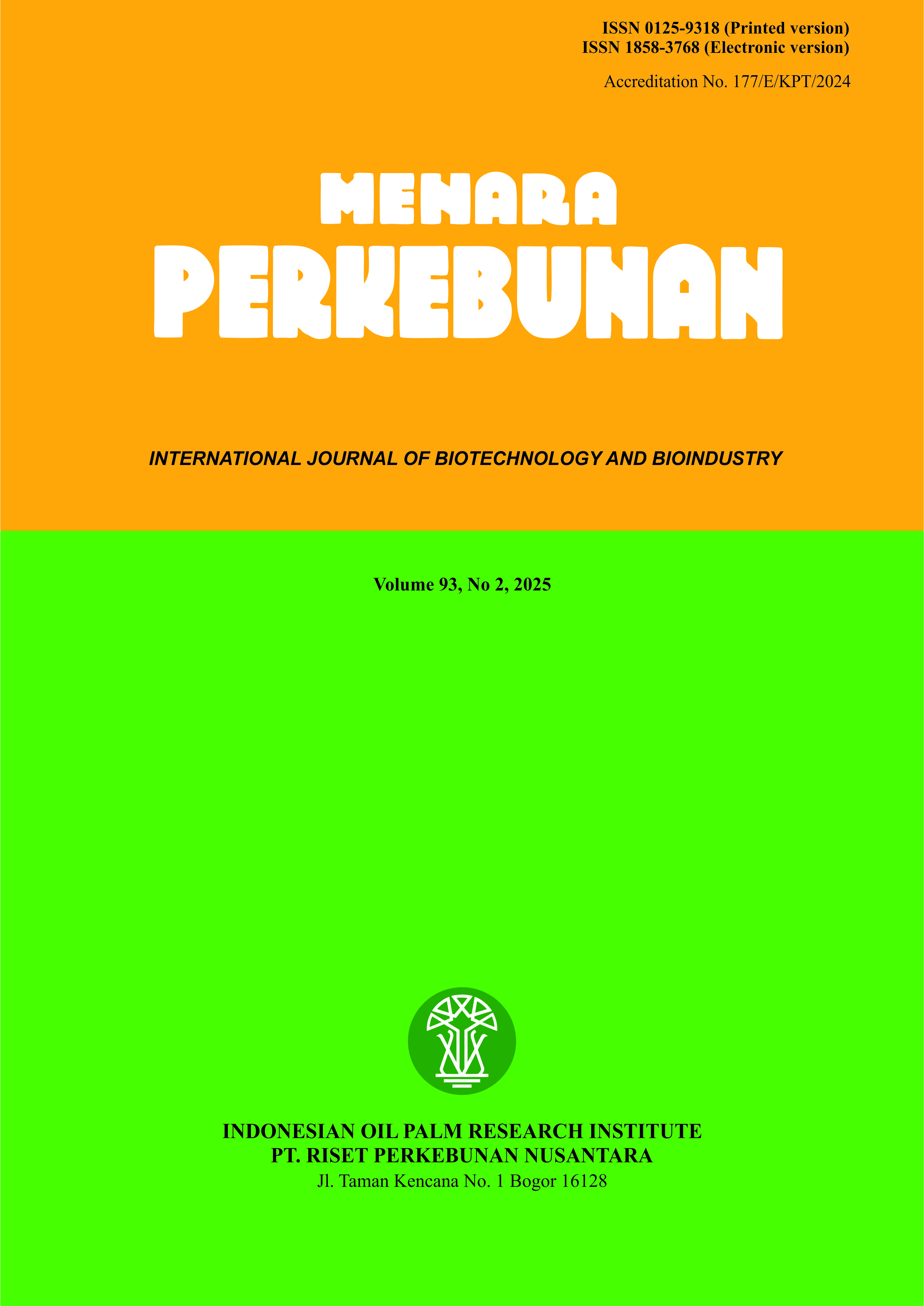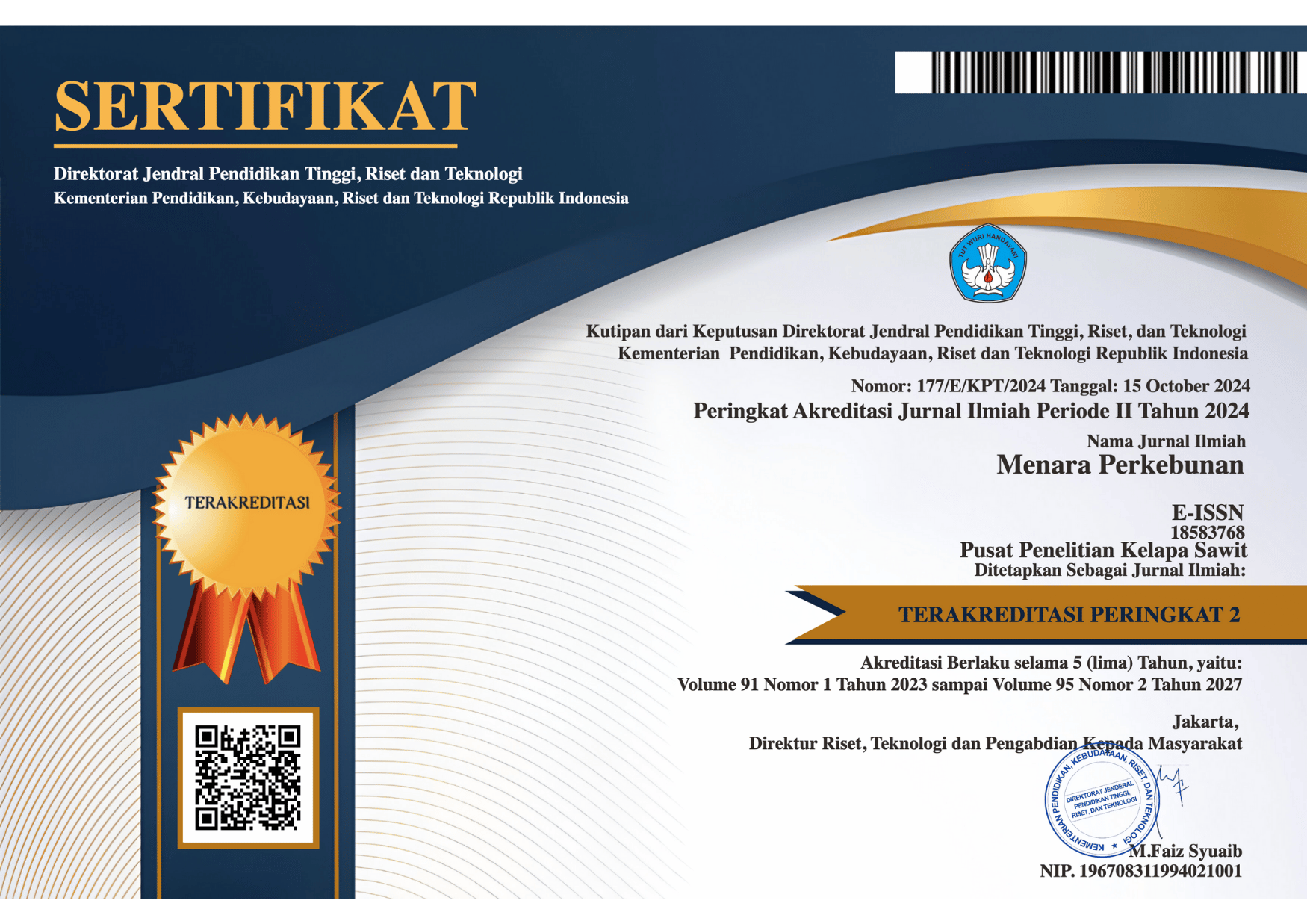Factors affecting crude palm oil quality across the supply chain and implications for downstream industries in North Sumatra and Riau
DOI:
https://doi.org/10.22302/iribb.jur.mp.v93i2.646Keywords:
FFB quality, industrial requirements, palm oil processing, storage effects, transportationsAbstract
Crude Palm Oil (CPO) quality, which is vital for downstream industries, is affected by multiple supply chain factors. This study investigated these factors and industrial needs in North Sumatra and Riau, Indonesia's key provinces for CPO production. Methods included supply chain investigations Fresh Fruit Bunch (FFB) production, Palm Oil Mill (PMO) processing, and CPO transport/storage, a refinery case study, and a Focus Group Discussion (FGD) with downstream industries. FFB handling practices, including loose fruit diversions, impacted mill intake quality. PMO processing significantly altered Free Fatty Acid (FFA), Moisture and Impurities (M&I), and Deterioration of Bleachability Index (DOBI). Substantial DOBI degradation and FFA increases occurred during CPO transportation and storage at the refinery due to oxidation and hydrolysis. Downstream, the refining and oleochemical sectors require high CPO quality (e.g., high DOBI and low FFA), whereas the biodiesel sector is more flexible. PMO operational alignment with advanced quality metrics like DOBI was limited. This study concludes that CPO quality is vulnerable throughout its supply chain, particularly post-milling. The findings necessitate an integrated approach that includes improved FFB handling, optimized PMO processing, and enhanced logistics to minimize degradation and align production quality with the specific demands of each downstream sector. Such an approach is crucial for improving the overall efficiency and competitiveness of the Indonesian palm oil industry.
Downloads
References
Pusat Data dan Sistem Informasi Pertanian Kementerian Pertanian. (2022). Analisis PDB sektor pertanian tahun 2022.
Arif, M., Sirlyana, S., Hadiguna, R. A., & Patrisinia, R. (2024). CPO Delivery Control in The Palm Oil Agro-Industry: A Literature Review. Proceeding of International Conference on Multidisciplinary Research, 2(1), 1–16. https://doi.org/10.2207/jjws.91.32
Azmi, S., Dorliana Sitanggang, K., Triyanto, Y., & Rizal, K. (2024). Analysis of Water Content, Free Fattyacids and Gross of Crude Palm Oil (CPO) in PMO PTPN IV Ajamu Labuhan Batu. Jurnal Agronomi Tanaman Tropika (Juatika), 6(2), 0–6. https://doi.org/10.36378/juatika. v6i2.3641
Choiruzzad, S. A. B., Tyson, A., & Varkkey, H. (2021). The ambiguities of Indonesian Sustainable Palm Oil certification: internal incoherence, governance rescaling and state transformation. Asia Europe Journal, 19(2), 189–208. https://doi.org/10.1007/s10308-020-00593-0
Foong, S. Z. Y., Andiappan, V., Tan, R. R., Foo, D. C. Y., & Ng, D. K. S. (2019). Hybrid approach for optimisation and analysis of palm oil mill. Processes, 7(2), 1–27. https://doi.org/10.3390/ pr7020100
Hidayat, A., Robiani, B., Marwa, T., Suhel, S., Susetyo, D., Mukhlis, M., & Asngari, I. (2020). Simultaneous equation of concentration, efficiency, and competitiveness of Indonesia’s CPO Industry: impacts and policies. Economia Agro-Alimentare/Food Economy, 27(1), 39–80. https://doi.org/10.3280/ecag2025oa18605
Imaroh, T. S., & Efendi, W. (2020). Quality control of palm oil production (crude palm oil) using SPC method (Case Study at PT. BPG). Advances in Economics, Business and Management Research, 120(Icmeb 2019), 160–166. https://doi.org/10.2991/aebmr.k.200205.030
Khatiwada, D., Palmén, C., & Silveira, S. (2021). Evaluating the palm oil demand in Indonesia: production trends, yields, and emerging issues. Biofuels, 12(2), 135–147. https://doi.org/ 10.1080/17597269.2018.1461520
Hudori, M., Iskandar, I., & Setyanto, D. (2023). Model formulation for estimating oil extraction rate to measure oil extraction efficiency in palm oil mill. Jurnal Sistem Teknik Industri, 25(1), 146–154. https://doi.org/10.32734/jsti.v25i1.10596
Mehraban, N., Kubitza, C., Alamsyah, Z., & Qaim, M. (2021). Oil palm cultivation, household welfare, and exposure to economic risk in the Indonesian small farm sector. Journal of Agricultural Economics, 72(3), 901–915. https://doi.org/10.1111/1477-9552.12433
Mohammad, S., Baidurah, S., Kobayashi, T., Ismail, N., & Leh, C. P. (2021). Palm oil mill effluent treatment processes—A review. Processes, 9(5), 1–22. https://doi.org/10.3390/pr9050739
Rahmah, K., Napitupulu, D., & Yanita, M. (2022). Analisis dampak kebun kelapa sawit terhadap sustainable development goals (SDGs) Indonesia. SIBATIK JOURNAL: Jurnal Ilmiah Bidang Sosial, Ekonomi, Budaya, Teknologi, Dan Pendidikan, 2(1), 105–114. https://doi.org/10.54443/sibatik.v2i1.505
Rosyadi, F. H., Mulyo, J. H., Perwitasari, H., & Darwanto, D. H. (2021). Export intensity and competitiveness of Indonesia’s crude palm oil to main destination countries. Agricultural Economics, 67(5), 189–199. https://doi.org/ 10.17221/371/2020-AGRICECON
Sampaio, K. A., Ayala, J. V., Van Hoed, V., Monteiro, S., Ceriani, R., Verhé, R., & Meirelles, A. J. A. (2017). Impact of crude oil quality on the refining conditions and composition of nutraceuticals in refined palm oil. Journal of Food Science, 82(8), 1842–1850. https://doi.org/10.1111/1750-3841.13805
Sari, R. M., Siagian, D. M., Erwin, Syahputri, K., Rizkya, I., & Siregar, I. (2021). Affecting factors of CPO yield: An identification. IOP Conference Series: Materials Science and Engineering, 1122(1), 012067. https://doi.org/10.1088/1757-899x/1122/1/012067
Sarjono, H., Christofer, K., Nayoan, G. F., & Nugraha, M. D. (2022). Performance analysis in palm oil industry using supply chain operations reference (SCOR) model. Binus Business Review, 13(2), 213–222. https://doi.org/10.21512/bbr.v13i2.8027
Sembiring, N., & Imam Ramzani, M. (2020). Determination of priority criteria which influences CPO factory productivity. IOP Conference Series: Materials Science and Engineering, 852(1). https://doi.org/10.1088/ 1757-899X/852/1/012095
Sihombing, L., & Purwoko, A. (2025). Challenges in the development of cooperative-based closed-loop refined palm oil agribusiness in Indonesia. Asian Journal of Agriculture and Rural Development, 15(1), 50–59. https://doi.org/ 10.55493/5005.v15i1.5306
Witjaksono, J., Yaumidin, U. K., Djaenudin, D., Astana, S., Harianja, A. H., Fery, S., Hasibuan, A. M., Khotimah, H., Hidayatina, A., Rusdin, Bungati, Imran, Rusdi, & Purba, R. (2023). The assessment of fresh fruit bunches supply chain of palm oil independent smallholder farmers in southeast Sulawesi. Uncertain Supply Chain Management, 11(3), 941–950. https://doi.org/10.5267/j.uscm. 2023.5.004
Downloads
Submitted
Accepted
Published
How to Cite
Issue
Section
License
Copyright (c) 2025 Donald Siahaan, Ilmi Fadhilah Rizki, Frisda Rimbun Panjaitan, Manda Edy Mulyono, Brahmani Dewa Bajra, Mulki Salendra Kusumah

This work is licensed under a Creative Commons Attribution 4.0 International License.
Authors retain copyright and grant the journal right of first publication with the work simultaneously licensed under a Creative Commons Attribution License that allows others to share the work with an acknowledgement of the work's authorship and initial publication in this journal.













